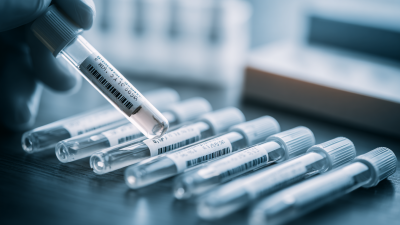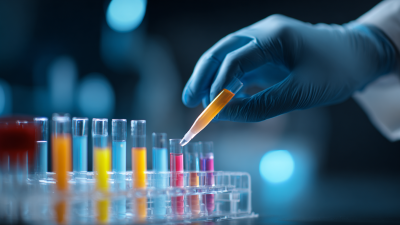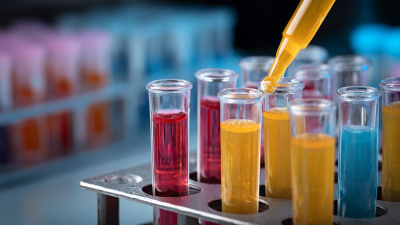How to Effectively Implement Molecular Diagnostic Equipment in Your Laboratory
Table of Contents
- Strategies for Selecting Molecular Diagnostic Equipment Based on Laboratory Needs and Capacity
- Understanding the Regulatory Landscape for Molecular Diagnostic Technology Acquisition
- Maximizing Return on Investment: Cost-Benefit Analysis of Molecular Diagnostic Equipment
- Training and Development Programs for Staff on Molecular Diagnostic Technologies
- Integrating Molecular Diagnostics into Existing Laboratory Workflows Effectively
- Leveraging Data Analytics for Optimizing Molecular Diagnostic Equipment Performance
- FAQS
- Conclusion
- Related Posts
In the fast-moving world of medical diagnostics these days, getting Molecular Diagnostic Equipment right is a big deal for labs that want to step up their testing game and give better outcomes for patients. Jiangsu Macro & Micro-Test Med-Tech Co., Ltd., which was set up back in 2010 in Beijing, really is leading the way with this tech revolution. They’re all about research, development, and selling top-notch detection tools and innovative in vitro diagnostic reagents. Thanks to their own cutting-edge tech and strong manufacturing skills, Macro & Micro Test helps labs smoothly incorporate molecular diagnostics into what they’re already doing. In this article, I’ll share some real-world tips and strategies to help you successfully bring Molecular Diagnostic Equipment into your lab, so you can stay competitive in a healthcare landscape that’s getting more and more complex.

Strategies for Selecting Molecular Diagnostic Equipment Based on Laboratory Needs and Capacity
Choosing the right molecular diagnostic equipment for your lab isn’t a decision to take lightly. You really need to get a good handle on what your lab actually needs and what your operational capacity is like. I came across a report from MarketsandMarkets that says the global market for molecular diagnostics is expected to hit about $11.4 billion by 2025. That’s a pretty clear sign that there's a big push towards precision medicine and targeted treatments nowadays. It kind of underscores how important it is not just to buy the latest tech, but also to make sure it’s suited to your specific needs—whether you’re focusing on detecting pathogens or analyzing genetic material.
When it comes to picking out instruments, labs should really take a close look at what they already have going on. Do they have the skilled staff? Is their space limited? For example, if space is tight, a smaller, all-in-one system might be the way to go. If they handle a lot of samples every day, then high-capacity machines could be more up their alley. Plus, Frost & Sullivan did a study that showed around 60% of labs put a high priority on equipment that plays nicely with their data management systems. That kind of integration makes things run smoother, helps avoid errors, and ultimately leads to better patient care. By carefully thinking through these factors and choosing equipment that lines up with their needs, labs can really level up their diagnostic game and push forward in clinical research and treatment."
How to Effectively Implement Molecular Diagnostic Equipment in Your Laboratory
| Equipment Type | Purpose | Key Features | Estimated Cost ($) | Laboratory Capacity (Samples/Day) |
|---|---|---|---|---|
| Real-time PCR Machine | Quantitative nucleic acid analysis | Fast results, Multiplexing capability | 15,000 | 100 |
| NGS Sequencer | Whole-genome sequencing | High throughput, Comprehensive data analysis | 250,000 | 50 |
| Microarray Scanner | Genomic profiling | High resolution, Comprehensive analysis | 80,000 | 75 |
| Digital PCR System | Absolute quantification of nucleic acids | Single molecule sensitivity, Robust data | 20,000 | 80 |
| Automated Liquid Handler | Sample preparation and handling | High throughput, Low carryover | 50,000 | 150 |
Understanding the Regulatory Landscape for Molecular Diagnostic Technology Acquisition
Getting a good handle on the regulatory landscape is super important when you're setting up molecular diagnostic equipment in your lab. Knowing what the regulatory agencies expect can really help you stay compliant and make the whole process of acquiring new tech a lot smoother. Lately, the market for lab-based IVDs has been really booming—it's expected to hit billions of dollars by 2030. This growth covers all kinds of products, from instruments and reagents to consumables, which are all essential if you want your diagnostics to be on point.
When you're thinking about new molecular diagnostic tools, it's not just about whether they work technically—you also gotta check out what regulations you need to follow for each product. And as industry reports are pointing out, the European market, especially for hospital infections diagnosed with molecular tests, is about to grow a lot. Types of infections like urinary tract infections will definitely increase the demand for quick and accurate diagnostic methods.
**Quick tips:** Keep your lab in the loop by subscribing to industry newsletters so you don't miss any updates on rules and regulations. It’s also a good idea to connect with other labs—share experiences and tips on implementing new technology. And don’t forget, regular staff training on compliance issues can really help your team stay on top of things and meet all the regulatory standards without too much hassle.

Maximizing Return on Investment: Cost-Benefit Analysis of Molecular Diagnostic Equipment
Bringing molecular diagnostic equipment into a lab can really be a game-changer. It’s a great way to boost the accuracy of diagnoses and make workflow smoother. Of course, investing in such high-tech gear isn’t just a small decision — it calls for a careful look at whether the benefits outweigh the costs. When you’re considering the investment, it’s not just about the purchase price and setting everything up; you also need to think about ongoing costs like maintenance and staff. By estimating how much more you can handle, the quicker turnaround times, and better patient results, labs can get a clearer picture of what they’re really getting out of the investment.

Plus, having the latest molecular diagnostic tools can give a real edge in today’s healthcare market. Labs with cutting-edge tech can draw in more clients, deliver results faster, and offer a wider range of tests that meet growing clinical needs. When you’re figuring out whether the ROI makes sense, it’s important to weigh both the obvious benefits, like increased revenue from new testing options, and the less tangible ones—things like boosting your reputation and keeping patients happy. If you take the time to weigh all these factors, you’ll be in a stronger position to decide if investing in molecular diagnostics is worth it—and it’ll help set the stage for long-term growth in a competitive space.
Training and Development Programs for Staff on Molecular Diagnostic Technologies
Bringing molecular diagnostic equipment into a lab is definitely a big step forward in improving how accurate and efficient diagnoses are. That said, the technology itself isn’t enough—what really makes a difference is having solid, well-thought-out training programs for your team. You know, according to the Clinical Laboratory Improvement Amendments (CLIA), about 80% of lab errors actually come down to staff not being properly trained. So, it’s super important to invest in comprehensive training to give your staff the skills they need to handle these advanced systems confidently.
When you’re putting together these training programs, try to include hands-on workshops. Nothing beats actually working with the equipment yourself—it helps build confidence and makes the learning stick. And don’t forget, ongoing education is key. Regular updates about newer molecular diagnostic techniques keep everyone sharp. In fact, a study by the American Society for Clinical Pathology showed that labs that keep their team updated and trained see around a 25% bump in diagnostic accuracy.
Oh, and training shouldn’t just be about the tech stuff. Soft skills like teamwork and good communication are just as important—they really help improve collaboration. Creating a work environment that promotes sharing ideas and solving problems together can make a big difference in how well the whole lab performs. Plus, peer-led learning sessions can foster a sense of continuous improvement and innovation. It’s all about building a culture that encourages growth, right?
Integrating Molecular Diagnostics into Existing Laboratory Workflows Effectively
Bringing molecular diagnostics into your existing lab workflows isn’t just plug-and-play — it takes some planning. First off, it’s super important to really understand how your current processes are set up. Basically, you want to spot those key spots where molecular diagnostics can make a real difference — like figuring out infectious diseases or genetic issues. Once you know where the gaps are, you can better decide how to use your resources and tweak your existing equipment to fit these new tools smoothly. No one wants a workflow nightmare, so smooth integration is the goal here.
And let’s not forget, training your team on the new equipment and techniques is a must. Giving your staff solid, hands-on training makes a huge difference—it helps them get comfortable with the new tools, run tests more accurately, and make sense of the results. Building a bit of a team mindset — sharing knowledge, solving problems together — can really boost the whole process. If you focus on these steps, your lab can work more efficiently, which means better patient care and even faster scientific discoveries. It’s all about taking those gradual, thoughtful steps to upgrade how things run — and honestly, it’s pretty exciting stuff.
Leveraging Data Analytics for Optimizing Molecular Diagnostic Equipment Performance
In today’s fast-changing world of molecular diagnostics, using data analytics is more important than ever for making diagnostic equipment work better. I came across a recent report from Grand View Research that projects the molecular diagnostics market will hit around $11.5 billion by 2025. That really shows just how much labs are leaning on precise, reliable diagnostic tools these days. By incorporating smarter data analytics, labs can tap into huge amounts of information, which helps them streamline their workflows, get test results faster, and make sure those results are as accurate as possible.
On top of that, predictive analytics can be a total game-changer when it comes to maintaining equipment and keeping things running smoothly. There’s actually a study in the Journal of Clinical Microbiology that found using predictive maintenance strategies cut equipment downtime by about 30%. That means labs can keep working without interruptions and still deliver quality results. With data analytics, folks in labs can spot patterns that hint at upcoming maintenance needs—kind of like catching issues early before they become a big deal. This proactive approach not only helps extend the life of pricey diagnostic machines but also means patients get faster, more dependable results, which is what really counts in the end.
Performance of Molecular Diagnostic Equipment Over Time
FAQS
: Key considerations include the initial costs of acquisition and installation, ongoing operational expenses such as maintenance and staffing, potential gains from increased throughput, and improved patient outcomes.
Molecular diagnostic tools can help laboratories attract more clients, reduce turnaround times, and offer comprehensive testing that meets evolving clinical demands.
Both tangible benefits, like increased revenue from new tests, and intangible benefits, such as enhanced reputation and customer satisfaction, should be considered.
Conduct a thorough assessment of current processes, identify areas for enhancement, allocate resources, and configure equipment for integration.
Comprehensive training programs empower staff to effectively operate the equipment, perform accurate tests, and interpret results, ensuring successful implementation.
Establishing a culture of collaboration encourages knowledge sharing and fosters a supportive environment for troubleshooting and innovation among teams.
Enhanced workflows and improved diagnostic capabilities contribute to better patient outcomes through more accurate and timely testing.
Laboratories must consider maintenance costs, staffing needs, and potential training expenses as part of ongoing operational expenses.
By justifying their investment through a thorough cost-benefit analysis, laboratories can position themselves for sustained growth in a competitive healthcare environment.
The first step is to conduct a thorough assessment of current laboratory processes to identify specific areas where molecular diagnostics can enhance capabilities.
Conclusion
Setting up molecular diagnostic equipment in a lab isn’t just about buying the gear; it’s about taking a smart, well-rounded approach that fits what your facility really needs and can handle. First off, you gotta look into those regulatory requirements—trust me, making sure you're compliant saves a lot of headaches down the line. Then, doing a detailed cost-benefit analysis really helps you figure out if the investment is worth it, so you’re not overspending or under-utilizing resources. And don’t forget, training your staff well is key—getting everyone up to speed on the new tech ensures everything runs smoothly.
On top of that, integrating this fancy new equipment into your existing workflow is absolutely critical. The last thing you want is it sitting idle or messing up your processes. Using data analytics can be a game-changer here, offering insights that can really level up your efficiency and accuracy. Companies like Jiangsu Macro & Micro-Test Med-Tech Co., Ltd., stand out because they’re all about innovation and top-notch quality. Their work really shows how these new tools are transforming the world of molecular diagnostics—it's pretty exciting stuff!
Related Posts
-

How to Effectively Detect Dengue Fever Using Antigen and Antibody Testing Methods
-

Future Trends in Gene Cyp2c19 Market Analysis for 2025 and Beyond
-

7 Reasons Why Choosing a Wholesale Rapid Diagnostic Test for Dengue Manufacturer Matters
-

5 Unforgettable Reasons to Choose the H1N1 Real Time PCR Kit for Accurate Testing
-

Solutions for Effective Dengue Test Antigen Procurement Management
-

How to Determine the Best GBS Price for Your Business Needs

